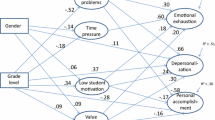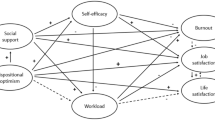Abstract
This study addressed the questions of whether selected teacher and organizational variables contributed to (a) significant amounts of variance in teachers' scores on three components of burnout, and (b) teachers' intentions to leave special education teaching. Study participants (N =490) included a sample of respondents to a survey of all of the 1096 special education teachers in Hawaii. Instruments used in this study included the Maslach Burnout Inventory, the Porter Need Satisfaction Questionnaire, and the Special Education Teacher Survey. Results of multiple regression analyses indicated that for the burnout components, Emotional Exhaustion and Depersonalization, relatively large and significant amounts of variance could be accounted for by a set of predictor variables. For the third burnout component, Personal Accomplishment, the variance accounted for by a set of predictor variables was significant but small. Stepwise discriminant function analysis was used to distinguish between teachers who stated they did or did not intend to leave special education teaching. Eight variables were identified as predictors of “Intention to leave special education teaching, ” correctly classifying 73% of teachers into the appropriate “Yes-Leaving” and “No-Leaving” groups.
Similar content being viewed by others
References
Akin, J. N. (1988).Teacher supply/demand report. Addison, IL: Association for School, College and University Staffing.
Association of State Colleges and Universities (September 15, 1988).Memo to the President, 28 (14).
Bogenschild, E., Lauritzen, P., & Metzke, L. (1988).A study of teacher attrition. Reston, VA: National Clearinghouse for Professions in Special Education.
Feistritzer, E. (1984).Teacher supply and demand surveys. Washington, D.C.: National Center for Education Information.
Hawaii State Teachers Association (1991).Special Education Teacher Survey. Unpublished survey instrument.
Jackson, S. E., Schwab, R. L., & Schuler, R. S. (1986). Toward a understanding of the burnout phenomenon.Journal of Applied Psychology, 71(4), 630–640.
Maslach, C., & Jackson, S. E. (1986).Maslach Burnout Inventory Manual (2nd ed.). Palo Alto, CA: Consulting Psychologists Press.
National Center for Education Statistics (1985).Condition of education. Washington, D.C.: U.S. Department of Education.
National Center for Education Statistics (1988).Targeted forecast. Washington, D.C.: U.S. Department of Education.
National Education Association (1987).The status of the American school teacher, 1985–86. West Haven, CT: Author.
Porter, L. W. (1963). A study of perceived need satisfactions in bottom and middle management jobs.Journal of Applied Psychology, 45, 1–10.
Trusty, R. M., & Sergiovanni, T. J. (1966). Perceived need deficiencies of teachers and administrators: A proposal for restructuring teachers' roles.Educational Administration Quarterly, 1, 168–180.
Author information
Authors and Affiliations
Additional information
This research was conducted in partial fulfillment of requirements for the Doctoral dissertation by the first author.
Rights and permissions
About this article
Cite this article
Carlson, B.C., Thompson, J.A. Job burnout and job leaving in public school teachers: Implications for stress management. Int J Stress Manage 2, 15–29 (1995). https://doi.org/10.1007/BF01701948
Issue Date:
DOI: https://doi.org/10.1007/BF01701948




